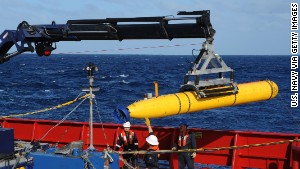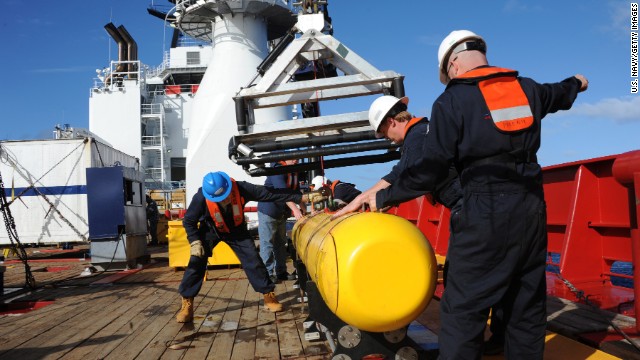April 17, 2014 -- Updated 1034 GMT (1834 HKT)
STORY HIGHLIGHTS
- NEW: A preliminary analysis of an oil sample shows that it is not aircraft engine oil
- "The search will always continue. It's just a matter of approach," Malaysian official says
- He did not provide a time frame on the search, but said it will be intensified
- Search crews are awaiting data analysis following scan by underwater drone
(CNN) -- A prolonged undersea search for the Malaysian jetliner could cost nearly a quarter billion U.S. dollars if private companies are used, Australia's top transport official said Thursday.
Martin Dolan emphasized that the $234 million price tag is a "ballpark rough estimate" of an extended search and salvage mission.
Searchers seem to be preparing for the possibility that an underwater drone scan of the southern Indian Ocean may not yield immediate debris from Malaysia Airlines Flight 370.
If no traces of MH370 are found, officials will be forced to review the operation and find a way forward, the Malaysian acting transport minister said Thursday.



"There'll come a time when we need to regroup and reconsider," Hishammuddin Hussein said. "But in any event, the search will always continue. It's just a matter of approach."
A later phase could involve a search along a large portion of sea highlighted by a partial digital "handshake" between the jetliner and a Inmarsat PLC satellite, Dolan said.
That arc of sea is over 370 miles long and 30 miles wide.
Underwater search
For now, search crews are awaiting data analysis following a scan by the underwater drone, which completed its first full mission Thursday.
Bluefin-21 has now searched a total of 90 square kilometers (34.7 square miles) in its first three trips to the ocean floor.
The Bluefin was forced to abort its mission twice this week; the first time after it exceeded its depth limit and the second time over a technical issue. After the latter was resolved, officials dipped it into the ocean again.
Data from its second and third mission have been downloaded, the Australian Joint Agency Coordination Centre said.
The underwater vessel takes two hours to get near the ocean floor and another two hours to return to the surface. It aims to map the ocean floor for 16 hours to retrieve data, which then take four hours to analyze.
The vessel searches maximum depths of 4,500 meters (14,764 feet). The U.S. Navy has determined the seafloor in the search area reaches a maximum depth of 4,600 meters (15,092 feet).




Bluefin operators said they can reprogram it to operate at 5,000 meters (16,404 feet), giving it more leeway.
New setbacks
Officials believe a recent ping heard in the search area has the right frequency to belong to the flight data recorder's emergency beacon.
The quality of the "ping" led authorities to focus the underwater search in the area.
And as the underwater focus continues, officials faced other setbacks.
Preliminary analysis of an oil sample collected in the southern Indian Ocean shows that it is not aircraft engine oil or hydraulic fluid, Australia's Joint Agency Coordination Centre said Thursday.
Malaysia Airlines Flight 370 vanished on March 8 with 239 people aboard after taking off from Kuala Lumpur, Malaysia, bound for Beijing.
With no debris found so far and no possible pings from the plane's "black boxes" detected in a week, officials shifted focus of the search underwater.
Air and sea surface searches continued Thursday about 2,170 kilometers (1,348 miles) northwest of Perth.
Those searches are probably nearing an end, officials said.
Disgruntled families
A technical glitch during a video conference to update Chinese families Wednesday turned into a screaming match.
"You're all bloody liars, and you're lying to us again," one man yelled.
Families of the passengers attending the Beijing briefing exploded in anger and stormed out.
Chinese relatives of those aboard the flight have accused Malaysia of withholding information. They demanded an apology from the Malaysian diplomat behind the botched briefing.
"We will request their team of experts to come to Beijing to conduct face-to-face communications and fulfill their commitment," said Jing Hui, a spokesman for some of the families. "What is the truth? What problem do they want to cover up?"
The families have 26 questions they want answered. They included requests for shared evidence, including the flight's logbook and recording of air traffic control the night the plane disappeared.
Most of the people on the plane were Chinese. Their relatives families have become distrustful of Malaysian authorities and airline officials.
Hishammuddin defended his government's handling of the operation and accused the media of focusing on the Chinese families. He said relatives of other nations represented have not had problems.
"The most difficult part of any investigation of this nature is having to deal with the families in our case," he said.
A Malaysian delegation will travel to Beijing in a few days to advise families on the ongoing search.
Malaysia has put together a committee to work with the relatives, he said.


No comments:
Post a Comment